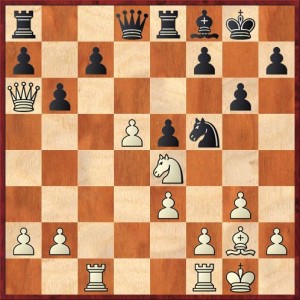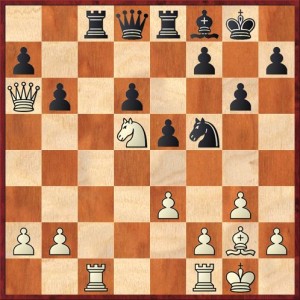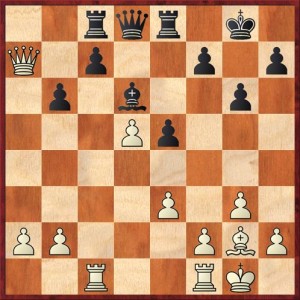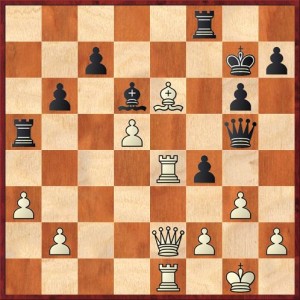Yesterday, at Mike Splane’s latest chess party, WFM Uyanga Byambaa showed us one of her games from the Norcal Chess Invitational, played in March 2012. There’s one position that I felt was super-instructive, although the conclusions I drew from it are a little bit debatable (and I would love to see some debate here).
Uyanga (rated 2110) was playing in the first round against Tigran Ishkhanov (2396), who outrated her by nearly 300 points. She is just learning the King’s Indian Defense and she mishandled it slightly, leading to the following position on White’s 20th move.
FEN: r2qrbk1/p1p2p1p/Qp4p1/3Ppn2/4N3/4P1P1/PP3PBP/2R2RK1 w – – 0 20
What do you do as White here? More importantly, how do you decide what to do?
I have to admit that when I was watching the game I got a little bit impulsive here. [I would say “too impulsive” except that one of my readers, Cortiano, recently informed me that there is no such thing as “too impulsive”!] Anyway, I immediately blurted out, “d6! What about d6?” We started analyzing the move — more on that below — but then after a minute or so Mike interrupted the discussion.
“We’re doing it again,” he said. “We’re analyzing a variation before we have made a list of all the candidate moves. I think we need to decide on the candidate moves first.”
Some of us (I confess) were a little bit reluctant to step back from the exciting analysis, but eventually Mike carried the day. But I have to say that the listing of candidate moves did not prove all that successful. About four or five moves were suggested: 20. d6, 20. Qc4, 20. h4, 20. Qb7 (the move Ishkhanov actually played), and maybe some others I don’t remember. But within 30 seconds we were back to analyzing 20. d6 again.
In fact I think this position calls into question Kotov’s candidate-move approach. Because I think it may not be right at this point to develop a full list of candidate moves. I would argue that the only list White needs at this point is (1) 20. d6; (2) 20. Qb7; and (3) everything else, with option (3) to be considered only if (1) and (2) look unsatisfactory.
Why do I say this? It has to do with timing. The strategic point of Black’s last move is that she wants to play 20. … Bd6, which would stabilize her queenside and give her a playable game. Therefore, if White is going to strike along the long diagonal, it is now or never. He will never get another chance to play d5-d6. Therefore it is imperative to look at the consequences of (1).
It’s also essential to look at (2) because it simply wins a pawn, without very much risk. You have to take seriously a move that wins a pawn.
Other moves, to me, are sort of missing the point of the position. Mike’s move 20. h4, doesn’t make a lot of sense to me, and he even came to acknowledge that. When White has the advantage in the center and on the queenside, why is he wasting time on the kingside?
So suppose we decide over the board that we are going to privilege 20. d6 and 20. Qb7, and look at other possibilities only if there is a good reason to. Now how do we make up our mind between those two choices? To me it’s a question of style, perhaps a question of psychology, and of course concrete analysis.
Style: Are you a hard-headed materialist, or do you prefer creative chess? I don’t think that either one of these is wrong — but if you know which one you are and you stick to it, it will help you make decisions like these.
Psychology: Remember that White outrates Black by 300 points. Should this enter into the decision? In this circumstance one might argue that White should play the most risk-free continuation; just win the pawn now and expect that Black will make further mistakes later.
Concrete Analysis: To me, this is what starts tipping the scales toward 20. d6. First you have to see that if Black ignores the pawn and plays 20. … c5 (which was suggested at the party), White has the absolutely crushing move 21. d7! The pawn cannot be taken because of a fork on f6, and if 21. … Re6 then 22. Ng5 wins the exchange. Plus, the pawn on d7 is very much alive and dangerous. This is an example of what I once called a “berserker pawn” in one of my ChessLectures.
Second, if Black takes with either the knight or bishop White clearly stands much better. This is what Uyanga probably would have played: 20. … Nxd6 21. Nxd6 Bxd6 22. Bxa8 Qxa8. White has won the exchange for a pawn. Maybe Ishkhanov looked at this and said, “I would rather win a pawn than a half a pawn.” But consider this: Black’s position is lifeless. She has no counterplay. The bishop is hemmed in by its own pawns. To me, this looks like a position where White can torture Black forever and eventually win.
Third and last, if Black takes with the pawn then White gets a dominating position: 20. … cd 21. Nc3! Rc8 and here White can either take his pawn back right away with 22. Qxa7 or play the more positional 22. Nd5 (see diagram).
FEN: 2rqrbk1/p4p1p/Qp1p2p1/3Npn2/8/4P1P1/PP3PBP/2R2RK1 b – – 0 22
Although Richard Koepcke and Mike Splane tried to convince me that 22. Qxa7 is better, I’m still going with this move. White can win the a7 pawn any time. I love the way that the knight on d5 dominates FOUR Black pieces. It prevents the rooks from moving to e7 or c7, prevents the queen from moving to d7, and because it blockades the d-pawn, it prevents Black’s bishop from moving anywhere!
Seeing how great all these variations are for White, it would be hard for me to choose any other move than 20. d6. To me, this is how chess is meant to be played. With 20. d6, you are opening up so many great lines for your pieces: the long diagonal for the bishop, the d5 square for the knight, the seventh rank for the queen. And meanwhile, by luring Black’s pawn to d6 you are restricting this scope of his pieces. If you “talk to the pieces,” as GM David Norwood says, you’ll find that they are unanimously in favor of this move.
Contrast this with 20. Qb7, a move that doesn’t improve White’s pieces in any way, misplaces the queen a long way from the action, and whose only redeeming virtue is that it wins a pawn. Of course, for some people that is a heck of a big redeeming virtue. Apparently that is the case for Ishkhanov, who played 20. Qb7 Rc8 21. Qxa7 Nd6 22. Nxd6 Bxd6 (diagram).
FEN: 2rqr1k1/Q1p2p1p/1p1b2p1/3Pp3/8/4P1P1/PP3PBP/2R2RK1 w – – 0 23
So here we are. White is a pawn up. But as they say, it is “just” a pawn; aside from this he has no other advantages. Black has a solid defensive setup, White’s bishop has been emasculated, … Ra8 is a threat, and also Black has a very natural plan of expansion on the kingside with … f5, … f4 etc. The opposite-colored bishops work in Black’s favor in two different ways. First, in the middlegame, opposite-colored bishops often give the attacker the equivalent of an extra piece. Black is the only player in this position with an attack, so this benefits her. Second, if White does manage to retain his extra pawn and exchange into an endgame, it’s still not going to be easy to win because of the drawish tendencies of OCB’s.
And another thing. I’ve just said Black’s plan is very easy to find. But what is White’s plan? The only idea I see for him is to play a2-a3, b2-b4, a3-a4-a5. But this is extremely difficult to accomplish; Black’s bishop on d6 and rook on a8 (eventually) are very well set up to prevent it.
For all of these reasons, I think that even a hard-headed materialist might concede that White went astray with 20. Qb7.
Anyway, what happened in the game was: 23. Qa4 f5 24. a3 f4 25. ef ef 26. Bh3 Ra8 27. Qc4 Qg5 28. Be6+ Kg7 29. Rce1 Be5 30. Re4 Ra5 31. Qe2 Bd6 32. Re1 Rf8 (diagram).
FEN: 5r2/2p3kp/1p1bB1p1/r2P2q1/4Rp2/P5P1/1P2QP1P/4R1K1 w – – 0 33
Up to this point I don’t think that either player has done anything overwhelmingly good or bad. It’s an amusing position because White has created this huge lineup of pieces on the e-file, yet they are completely impotent as long as the bishop stays on e6, and when is it ever going to leave?
Again, it’s hard to figure out a plan for White. The longterm plan probably has to begin with b2-b4, which is in fact playable here (because of the fork threat on b2), but is a very committing move. If you’re White you probably want to postpone such a move until after the time control, but the time control is still a long way (eight moves!) away.
Did I mention time trouble? That’s one thing that has changed in this position over the last ten moves, and not in a good way for White. Also, there had to be a certain amount of frustration for White in seeing a position where he had a clear advantage turn into a defensive battle. So for whatever reason — time trouble or frustration or both — he played two terrible moves in a row:
33. h4? (weakening the king) 33. … Qf6 34. b4?? (Now this simply drops a pawn for no compensation) and the game ended quickly: 34. … Rxa3 35. gf Bxf4 36. Qg4 Bd6 37. R1e2 Ra1+ 38. Kg2 Ra3 39. Re3?? Rxe3 and White resigned, seeing that either way of recapturing leads to checkmate.
A very nice comeback by Uyanga. Ishkhanov is the highest-rated player she has ever beaten!
By the way, you can find the complete game score and her annotations on her new blog. Welcome to the chessoblogosphere, Uyanga!
Interestingly, Uyanga does not say one word in her analysis about the key position on move 20. That is perhaps understandable because she is mostly concerned with what she could have done better, not what White could have done better. Still, I think you’ll get the most out of postmortem analysis if you put both your decisions and your opponent’s decisions under the microscope. That’s one reason Mike’s chess parties are so great; they force you to question everything!







{ 7 comments… read them below or add one }
Dana and I have very different styles of playing chess. In any earlier blog Dana wrote:
Mike showed us another one of his recent games, which I thought was very interesting as an illustration of what the Russians would call “nichevo-ne-delanye“: not doing anything. Sometimes you don’t have to do anything to win a chess game. If you get in a superior position, you can sometimes just sit on it, make a little threat here and a little threat there, and just let the opponent wear himself out with the onerous task of defending. Eventually the opponent will crack and make a mistake (or two or three …) and then you win.
I am not very good at this “nichevo-ne-delanye” style of playing chess — I am always too impatient to make things happen.”
And in another blog he wrote:
“Here I would be looking at all sorts of exchange sacrifices, on f2 or g3, and they might even work, but Mike has a different philosophy. Instead of giving away your material, why don’t you just wait for your opponent to give you his?”
We also analyze positions differently. I’m trying to think in general plans, Silman calls it “reading the language of the position”, and Dana is adopting a more concrete approach.
Dana’s approach is useful in some stuations. Pcking one move that looks good, analyzing it, and playing it is very efficiet if you are under time prerssure and need to play quickly. And If there is an immediate tactical solution, then forcing moves are called for.
By contrast, I feel uncomfortable with trying moves at random and hoping they are the best, when there are better methods available.
I think our approach to the position in the first diagram s a good example of the difference in our two styles.
Since there is no immediate tactical solution, and since we were not analyzing under time pressure, I wanted to use a more controlled approach to understanding the position, so i did not want to jump in to loing at a single candidate move.
That being said, I also wanted to look at 20. d5-d6. If I was playing a speed chess game that would have definitely been my first choice. I do think the resulting position is quite good for White.
However I see nothing wrong with White’s original position. He has a nice solid space advantage and Black’s position is full of weak squares, so White does not have to be in a hurry and I think there is time for a more patient approach. Forcing moves are not always best.
One way to try to understand positions without relying on a brute-force approach is to try to identify the key positional factors.
Here I would say the pawn on c7 is holding Black’s position together so White’s plan should be focused on eliminating that pawn. If he can establish a rook on c7 the game is positionally won.
A second key factor is the dominating position of the white knight. If Black tries efending the c7 square with … Bd6 White can double rooks on the file and then take the bishop. so Black should be trying to dislodge the knght with either … Nd6 or … f5 Since White had a bind on the center and queenside, Black’s play must come on the kingside.
Putting these ideas together, is there any way for White to put pressure on the c7 pawn, maintain his knight in the center, and prevent Black from advancing her kingside pawns?
Doubling rooks on the c-file is too slow. After any move of the c1 rook Black can play 20 … Nd6. In fact, that is Black’s real threat in this posiiton, not Bd6 as we thought during the analysis at my party.
However, there is a faster way. After 20. Qc4 Black has three ways to defend the pawn.
If 20 … Re7 21. d6 wins the exchange.
If 20 … Rc8 21. Bh3 and Black is completely tied up, or White can play 21. Qa4 threatening to take on a7 and on e8 and winning material. Personally I would play Bh3. As I mentioned at the party, Lasker once said the “rook pawns are worth less than a tempo” so I was not in favor of White’s plan of winning this unimportant pawn.
If 20 … Bd6 White can play 21. Qa4, threatening to take on e8, followed by doubling rooks on the c-file. He doesn’t have to be in a hurry, none of Black’s pieces are active enough to create threats. After White had doubled rooks the capture on d6 should be winning, or he can continue to build his position and wait for Black to self destruct. Personally I would just play a few moves to see what she would do before cashing in.
Now the big question is whose approach is best?. I think thias time it’s a toss up, both plans are good.
Dana, thanks for writing this. It’s good to get feedback about the flaws in my own thinking processes. The chess discussions are great precisely because of everyone’s differences.and our eagerness to consider each other’s ideas. I always learn a lot from the others amd it is helping me to become a better player.
What a great comment! This is really what I wanted to get out of the discussion, an idea of how someone else thinks about the position. At the parties it is, unfortunately, not always possible to communicate the thought process so coherently. Twelve other people also trying to say what they think, and there’s just not enough time, actually, to figure out what you really want to say. For this sort of thing the written word is better.
My takeaway from this position is: watch for the tendency to become overcautious in positions where I have a clear (but not winning) advantage.
It’s well known that the player in an objectively lost position can play much more freely and easily – s/he has “nothing left to lose.” Just like in the song.
But the converse is also true – the more we’ve gained, the more we feel the need to “hold on to it,” which can cramp the very style and creativity which brought about our advantage in the first place.
Although d6 is probably the best move (as we analyzed yesterday), I think the problem was not so much that white grabbed an unimportant pawn, but that he did not sense the danger inherent in the position. It is clearly apparent in this position that black’s chances are connected with the pawn push f5, and then f4, together with some nebulous minor piece activity.
Qb7 wouldn’t actually have been so bad a move if white had an extra knight – in which case, he could have been able to employ the standard KID prevention of threatening to take over e4 after f5.
But after Qb7, white not only lost tempi on the queen, but (I think) his position became a little sterile. Also, owing to the very few minors left on the board, he couldn’t stop the f5 attack very well.
Ashish makes a good point, about playing too conservatively. A good question to ask is if your advantage is of a permanent or temporary nature. If it is temporary, due to one player having more active pieces or an exposed king, then active measures are called for.
Like most chessplayers, I started out with the tendency to play the most forcing move every time. but now I have learned the value of patience. A couple of major influences on me were a chapter in Shereshevsky’s book “Endgame Strategy” called “Do Not Hurry” and a chapter in Aagaard’s book “Excelling At Chess” called “Unforcing Play.”
If we go back to the original diagram, look at my first post, and evaluate the positions after the lines starting with 20. and 20 Qc4 it is obvious that 20 Qc4 is not the best continuation. Both plans keep the space advantage, but Dana’s plan converts a temporary advantage, more space, into a permanent one, connected passed pawns, while maintaining the space advantage,
So was my key factors method a failure?
Not really. I pointed out that White had two problems to solve, removing the c7 pawn and safeguarding the central position of the knight while preventing its exchange. Qc4 resolves the issues in a static fashion but d6 also resolves the same issues. If you had infinite time you would want to consider both lines.
BTW, as I mentioned in the first post, my intuition also told me 20. d6 was the right move, and was the move I would have played if moving quickly was required.
Moving on I’d like to discuss another position
If we take a look at the position after 20. d6 cd6 21. Nc3 Rc8 Dana points out that Richard Koepcke and I were advocating taking the a-pawn and he was advocating Nd5.
This is not quite correct. I was not advocating one move over another. Richard pointed out that moving the knight to d5 was not ALWAYS the best move in all positions and I agreed with him. In “My System” Nimzovich talks about putting knights on outpost squares to entice your opponent to push a pawn and eject your knight. This weakens the square in front of the knight outpost. After the pawn is deprived of protection, it is useful to attack it with a rook, and tying a piece down to its defense. Nimzovich goes on to say that after the pawn is already backward the outpost square can be used by the other pieces as well as the knight. Richard was pointing out this general principle.
I think Dana and Richard used a very similar thinking process in their choice of candidate move.
Richard instantly realized that the capture of the a7pawn was winning so didn’t want/need to look at other moves.
Dana instantly realized that the posting of the knight on d5 was winning so didn’t want/need to look at other moves.
Both players are quickly choosing the move that their intuition says is best and subjecting it to analysis before considering any other moves. Again, this is a very efficient thinking method when playing quickly is an issue.
Let’s look at the choice of moves, either 22. Nd5 or 22. Qa7, using my key factor method. After the a7-pawn falls, the key factor will be White’s queenside 2-1 pawn majority. Eventually the b6 pawn will be lost, either through capture or exchange, and White will create a winning passed pawn.
If we consider the position after each of the two candidate moves, 22 Qa7 and 22 Nd5, it is obvious that Dana’s move is stronger. After both moves the a7 pawn is lost, but after 22. Nd5 the b6 pawn also falls. White gets two passed pawns instead of one.
If you don”t have Dana’s ability of automatically knowing the strongest move at a glance, and I sure don’t, I hope you’ll find the key factors method useful.
I assume this last comment was meant with tongue in cheek! I’m playing this weekend in Pleasanton, and we’ll see if I “automatically know the strongest move at a glance.” I don’t think so…
Maintaining objectivity is a challenge for me. I know about candidate moves and try to apply the candidate-move approach in the abstract, but when I have a very strong intuitive feeling that one move is correct I have a hard time giving other moves a fair hearing, so to speak. This is a weakness.
Re-reading this blog post several years later, I’ve come around 100% to Dana’s view that 20. d6 is far superior to any other moves. The bishop on g2 is a bad piece as long as the pawn is on d5. If he doesn’t play 20. d6 right now he won’t ever be able to.